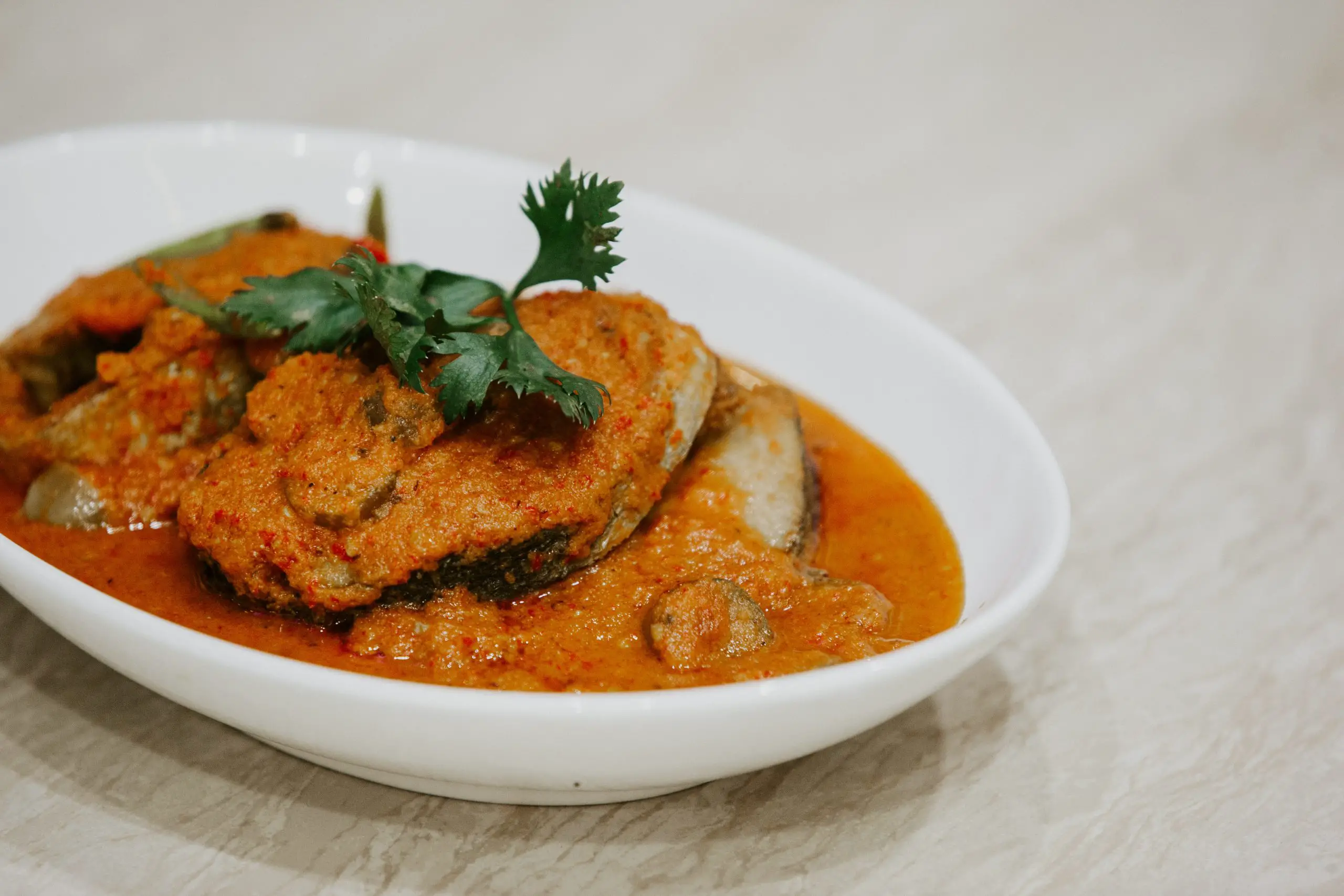Fish curry is a flavorful and satisfying dish that can be served hot or cold. Fish curry is a savory dish that can be prepared with various fish. Whether you’re making it at home or ordering it from a restaurant, it’s a common question whether fish curry can be reheated safely.
If you have leftovers from this tasty dish, you may wonder if you can pop them in the microwave or on the stove to heat them. So let’s get started! Reheating fish curry can help restore its flavor and texture, but some precautions must be taken to ensure the dish is safe to eat. This article will discuss the best ways to reheat fish curry and some storage and tips for reheating fish curry while preserving its flavor and texture.

Can you Reheat Fish Curry?
Yes, it is usually safe to reheat fish curry. However, there are a few things to keep in mind to ensure that the dish is properly reheated and remains flavorful and enjoyable. First, ensure that the fish curry has been thoroughly reheated to a safe internal temperature.
Heat the curry in the microwave or stove until it reaches an internal temperature of 165°F (74°C). This will help to kill any bacteria that may have formed during the cooling process. Second, consider the texture of the fish.
Overheating or reheating fish for an extended period can cause it to become dry and overcooked. To avoid this, gently heat the curry for a shorter period. Finally, adding some moisture to the dish while it’s reheating is a good idea.
You can safely reheat fish curry and enjoy it as a tasty leftover meal. To keep the curry moist while reheating, add a broth, coconut milk, or water splash. This can help keep the curry flavorful and enjoyable by preventing it from drying. Follow these guidelines to help preserve the flavor and texture of the dish.
Best Way to Reheat Fish Curry
The best way to reheat fish curry depends on the type of reheating method you have available and your personal preference. Reheating fish curry can be more difficult than other dishes because fish is more delicate and prone to drying or becoming overcooked.
However, with a little care and attention, you can easily reheat your fish curry and enjoy it just as much as when it was first cooked. Here are some ways to reheat fish curry:
1. Using the Stovetop to Reheat Fish Curry:
Reheating fish curry on the stovetop is a good option if you have a large quantity of curry or prefer a more traditional method of reheating. To do this, transfer the curry to a saucepan or pot and place it over low heat. Stir occasionally and add a bit of broth or water to the curry if it seems too thick or dry.
2. Using an Oven to Reheat Fish Curry:
Reheating fish curry in the oven is a good option if you prefer a hands-off method of reheating. To do this, transfer the curry to an oven-safe dish and cover it with foil. Put the dish in a preheated 350°F (180°C) oven and bake for 15-20 minutes, or until the fish is hot all the way through.
3. Using the Microwave to Reheat Fish Curry:
Reheating fish curry in the microwave is a convenient and quick option if you have a small quantity of curry or are short on time. To do this, transfer the curry to a microwave-safe container and cover it with a lid or plastic wrap. Heat the curry in short intervals, stirring after each interval to help distribute the heat evenly.
Regardless of your chosen method, it’s important not to overcook or dry out the fish during the reheating process. Use low heat, add moisture to the curry if needed, and test the temperature of the fish to ensure that it’s hot all the way through before serving. Following these steps, you can safely reheat your fish curry in the microwave and enjoy it just as much as when it was first cooked.
Additional Tips to Reheat Fish Curry Safety:
- Low heat: Reheat the curry on low heat to keep the fish from becoming overcooked or dry. This allows the curry to heat up slowly while preserving the texture and flavor of the fish. Here are Some Additional Tips for Safely Reheating Fish Curry:
- As previously stated, adding a little moisture to the curry while reheating it can help prevent it from drying. To help keep the curry moist, add a splash of broth, coconut milk, or water.
- Stir frequently: While reheating the curry, stirring frequently can help to evenly distribute the heat and prevent hot spots or burnt areas.
- Cover the container: While reheating the curry, covering the container can help to retain heat and moisture, ensuring that the curry is heated evenly.
- Use a food thermometer: It’s a good idea to use a food thermometer to check the curry’s temperature to ensure that it has been reheated to a safe internal temperature.
- To destroy any germs that might have grown during the cooling process, the curry should reach an internal temperature of at least 165°F (74°C).
How Long can you Keep Fish Curry in the Fridge?
Fish curry can be kept in the refrigerator for up to 3-4 days. To extend the shelf life of the curry, you can freeze it for at least three months. Store the curry in a covered container to prevent contamination and keep it fresh.
However, remember that the curry’s texture and flavor may change after being frozen and thawed. It’s also a great idea to use a food thermometer to ensure that the curry has cooled to a safe temperature before storing it in the refrigerator.
Foods that are not cooled to a safe temperature within 2 hours of cooking can allow bacteria to grow, which can lead to food poisoning if not handled and stored properly. Overall, consume fish curry within 3-4 days of making it or freeze it for longer-term storage.
Is it Safe to Eat Cold Fish Curry?
Cold fish curry is generally safe to eat as long as it is handled and stored correctly. However, when served cold, the flavor and texture of the curry may change. Cold fish curry may be less flavorful than hot fish curry, and the fish may become firmer and denser in texture.
If you eat cold fish curry, ensure it is kept in the refrigerator at a safe temperature (below 40°F or four °C) to prevent the growth of harmful bacteria. To ensure that the curry is fresh and safe to eat, consume it within 3-4 days of making it.
Overall, cold fish curry is generally safe to eat if it is handled and stored properly. However, when determining whether or not a food is safe to eat, it’s always a good idea to use good judgment and common sense. To reduce the danger of food illness, throwing away any curry that raises concerns about freshness or safety is preferable.
How to Defrost Fish Curry?
You can defrost fish curry using one of the following methods: whatever method you use, handle the curry carefully to avoid tearing or breaking it. Once the curry has thawed, reheat it as described in previous answers and serve it as usual.
Method 1. Leave the Fish Curry in the Refrigerator:
This is the most effective and safest method for defrosting fish curry. Place the curry in a covered container and refrigerate it for several hours or overnight. This will allow the curry to gradually thaw while retaining its flavor and texture.
Method 2. Place the Fish Curry in a Bowl of Cold Water:
If you need to defrost the curry more quickly, you can place it in a bowl of cold water. Change the water every 30 minutes to ensure it stays cold and speed up the thawing process.
Method 3. Defrost the Fish Curry in the Microwave:
Another option is to microwave the curry for a few minutes on the defrost setting, checking and stirring every minute or so until it has thawed. If you microwave the curry for too long, it will become rubbery and lose its flavor.
How can you Tell if Fish Curry has Gone Bad?
On the other hand, if not handled or stored properly, it can spoil just like any other food. Knowing how to tell if fish curry has gone bad can help you avoid food poisoning and eat only fresh, safe food.
Here are Some Signs that your Fish Curry has Gone Bad:
- Off odor: A strong, unpleasant odor is one of the most obvious signs that fish curry has gone bad. If the curry has an off odor, it is likely spoiled and should be discarded.
- Visible spoilage: It is best to discard any curry that has mold, discoloration, or other visible signs of spoilage. These symptoms may indicate the presence of bacteria or other contaminants, making the curry unsafe to consume.
- Change in texture: If the curry had become slimy or had a texture that was noticeably different from when it was fresh, it may have gone better. This could indicate bacterial growth or other contamination.
- Change in flavor: If the curry has a sour, bitter, or otherwise off-taste, it may be spoiled. This could indicate that the curry has gone bad and should not be consumed.
When determining whether or not fish curry has gone bad, use your best judgment and common sense. If you have any questions about the freshness or safety of the curry, it’s best to throw it out to avoid food poisoning.
What are the Indicators of Food Poisoning from Fish?
Several signs and symptoms of food poisoning can occur after consuming contaminated fish. If you experience any of these symptoms after consuming fish, it’s important to seek medical attention as soon as possible.
In severe cases, food poisoning from contaminated fish can lead to serious complications such as dehydration, kidney failure, and even death. These may include:
- Nausea: A feeling of discomfort or sickness in the stomach that may lead to vomiting.
- Vomiting: The forcefully expelling of the stomach’s contents through the mouth.
- Diarrhea: The passing of loose, watery stools.
- Stomach cramps: Pain or discomfort in the abdomen.
- Fever: An increase in body temperature above the normal range.
- Headache: Pain or discomfort in the head or scalp.
- Fatigue: A feeling of tiredness or lack of energy.
Conclusion
Finally, reheating fish curry is an easy operation that enables you to enjoy this delectable dish as a great leftover supper. To guarantee that the curry is reheated correctly and retains its flavor and enjoyment, it’s crucial to adhere to a few guidelines. This can help keep the curry flavorful and enjoyable by preventing it from drying.
To safely reheat fish curry and maintain its flavor and texture, thoroughly heat it to a safe internal temperature, pay attention to the fish’s texture, and add moisture to the curry to stop it from drying. To keep the curry moist while reheating, add a broth, coconut milk, or water splash. Finally, adding some moisture to the dish while it’s reheating is a good idea.

